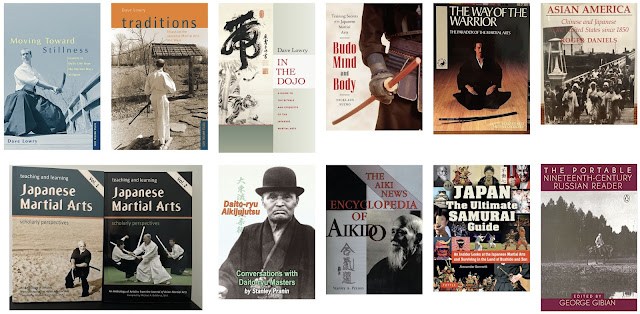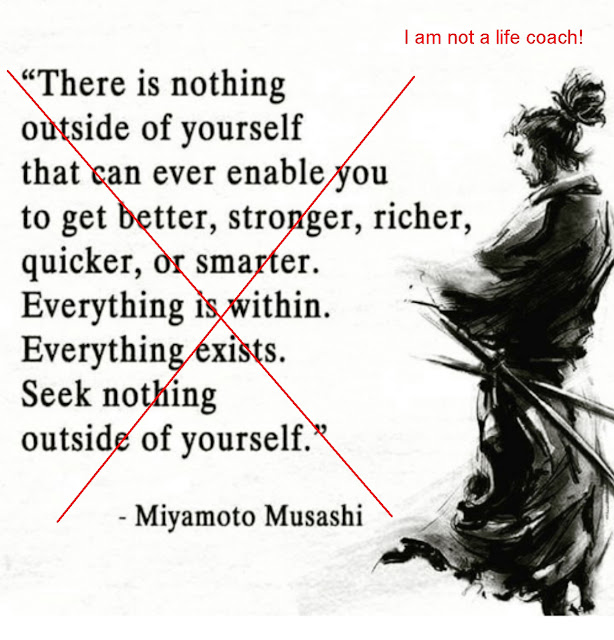July 2021 Book Survey: Budo and Associated Topics Part 2
My (Richard's) reading theme for July 2021 was books on budo and associated topics. This was an extension of my reading theme for June 2021.
Introduction
When I started this reading project in May 2020, I prioritized books on martial arts history. I read 34 books from May - November 2020 and reviewed several for Martial Journal. In December 2020 I started my current project, which involves reading 6-12 books per month and writing these monthly survey posts.
These titles are numbered 122-132 in my reading spreadsheet. That list extends to number 435, ending in June 2024. Beginning in July 2024, my remaining unread martial arts books all carry the label "technique." My library currently lists 225 print books and 563 digital books with the "technique" label. Some time in 2024 I will create a reading plan for those titles as well.
The goal of Martial History Team is to "promote martial arts history based on sound evidence and sourced research." I read these books to learn, but more importantly to identify titles that support the MHT goal.
With that explanation out of the way, here are a few words on the books from July 2021.
Moving Toward Stillness, Traditions, and In the Dojo, Dave Lowry, 2000, 2002, 2006
 |
Moving Toward Stillness, Traditions, and In the Dojo, Dave Lowry, 2000, 2002, 2006 |
I am probably not the intended audience for these titles, Moving Toward Stillness (2000), Traditions (2002), and In the Dojo (2006), by Dave Lowry.
If you are a member of the very small, and seemingly ever-shrinking, group of koryu practitioners, these books will likely resonate with you. I sensed that Mr Lowry has been upset ever since Bruce Lee arrived on the scene in the 1960s, and he is a fan of what Mr Lee termed "the classical mess."
For example, Mr Lowry calls the introduction of warm-up exercises "a mixed bag," and says there is no place for visitors in a "traditional" dojo because visitors are unwelcome or at best tolerated. I see this attitude regularly in koryu-themed social media groups, which is unfortunate and likely to doom these practices.
Overall these books are well-written, but the philosophy is not one with which I could align. The attitude is similar to that of the third volume of the Donn F. Draeger trilogy that I surveyed last month. If I had to recommend one, it would be In the Dojo, as it contains helpful etiquette for those who might want to study in one of these koryu dojos.
Incidentally, I greatly enjoyed books on koryu by Ellis Amdur, such as Hidden in Plain Sight, Old School, and Dueling with O-sensei, all of which I reviewed previously.
Budo Mind and Body, Nicklaus Suino, 1996/2007
 |
Budo Mind and Body, Nicklaus Suino, 1996/2007 |
The Way of the Warrior, Howard Reid and Michael Croucher, 1993/1995
 |
| The Way of the Warrior, Howard Reid and Michael Croucher, 1983/1995 |
You can find grainy versions of these videos on YouTube.
This book is a bridge between the unsourced, myth-based, and relatively lacking texts of the 1970s and the first appearance of more grounded, better-sourced books in the 1990s.
There are glimmers of leaving myths behind. For example, page 25 states that Bodhidharma is a "legend... [and] there is no clear evidence that points to China or India as the country where the martial arts first developed into the systems of action and thought that approximate to the Asian martial art of today." That's not bad, except the focus on China and India is a bit worrisome.
Sure enough, the other shoe drops on page 30:
"The birthplace of the martial arts was on the roads that bound these two great civilizations [China and India] together."
From that point forward, it becomes abundantly clear that this book has fallen for the "China is the source of all martial arts" trope, although it gives some credit to India by using the "roads" hack mentioned above. For example, on page 48 the authors write "Some Chinese forms are known [by whom?] to have reached South India centuries ago... To a trained eye they [Indian forms] are recognizably Chinese."
Although the book is light on myths in the early reading, later on it falls for the same tropes found in other books of the period. On pages 56-57, readers encounter "vital points," including 14 that cause "immediate death" in elephants. Readers see myths about Chinese triads and the "five ancestors" on page 62.
Despite looking beyond China to places like the Philippines or Japan, however, the book is totally ignorant of European martial arts. On page 31 the authors write "it will be some time before martial arts systems emerge that can be called European or American in the same way that, say, judo can be called Japanese." It's ironic that HEMA has styles with treatises that predate Asian martial arts by centuries, although the authors write on page 214 that "Research into the fighting skills and training regimes of medieval knights is patchy and almost nothing is known about the techniques they employed." While it is true that HEMA as a discipline is relatively new, the current practice is probably the third re-construction of those arts.
Probably the most troublesome China-centrism appears in the discussions on Japanese arts. Some of it is just wrong, as this statement on page 148: "In the times when the Tenshin Shoden Katori Shinto Ryu was founded, the martial arts in Japan were all referred to by one term: bujutsu." This terminology is probably due to Donn F, Draeger's influence, as is the reference to TSKSR as "a pure martial art" on page 118.
Page 192 has some of the most outrageous claims in the book:
"[Jigoro] Kano recognized that the roots of jujutsu lay in the soft, internal arts of China... Kano recognized these ancient Chinese roots and worked from them."
This is exactly the opposite of what Kano said and did, if the authors had bothered to read what Kano himself wrote in English about jujutsu and judo.
Overall, this book contains beautiful photographs and has high production value. I plan to watch the videos on YouTube. As a reliable source, however, I would avoid it.
Teaching and Learning Japanese Martial Arts: Scholarly Perpsectives, Volume 1 and Volume 2, Michael DeMarco, 2017
 |
| Teaching and Learning Japanese Martial Arts: Scholarly Perpsectives, Volume 1 and Volume 2, Michael DeMarco, 2017 |
I'd like to thank Via Media publisher Michael DeMarco for sending me print copies of Teaching and Learning Japanese Martial Arts: Scholarly Perpsectives, Volume 1 and Volume 2. These two titles contain articles from the Journal of Asian Martial Arts, from 1993 through 2011. These books are useful if one wants to see the sorts of mythological headwinds that martial arts studies were dealing with in the 1990s and even later. For example, one 1993 paper by Dr Harrison-Pepper begins with the familiar myths of Bodhidharma and Zen in the Art of Archery. Nyle Monday's 1994 article contains the trope that "the bugei are the true martial arts." Dr Carrie Wingate relies on the now-seen-as-unreliable 1973 work by Ratti and Westbrook, discussed here in April 2021. In general, then, I would avoid this collection. Even the fine work by Dr Cameron Hurst III can be found in his stand-alone publications.
Asian America: Chinese and Japanese in the United States since 1850, Roger Daniels, 1988
 |
Asian America: Chinese and Japanese in the United States since 1850, Roger Daniels, 1988 |
I bought Asian America: Chinese and Japanese in the United States since 1850 to get a better historical sense of the experience of Chinese and Japanese immigrants to the US, especially during the 19th century. The author is an expert on immigration but does not speak Chinese or Japanese. He writes well and includes plenty of footnotes. There is also a bibliography. This book did not really hold my attention after I finished the sections on the 19th century, and it did not seem to mention martial arts in any way. That was a disappointment. If anyone knows of a more recent book on this topic, please let me know.
Daito-ryu Aikijujutsu: Conversations with Daito-ryu Masters and The Aiki News Encyclopedia of Aikido, Stanley A. Pranin, 1996, 1991
 |
| Daito-ryu Aikijujutsu: Conversations with Daito-ryu Masters and The Aiki News Encyclopedia of Aikido, Stanley A. Pranin, 1996, 1991 |
The next two titles are must-have books for any aikido or daito-ryu aikijujutsu researchers. Daito-ryu Aikijujutsu: Conversations with Daito-ryu Masters and The Aiki News Encyclopedia of Aikido are two fine works by the late Stanley A. Pranin, published in 1996 and 1991 respectively. It's best to approach each book as a reference. I doubt most people would read them cover-to-cover.
In the first book, Mr Pranin states that his goal is to provide an English language resource based on Japanese material, to counter "factually unreliable" Western writings that suffer "due to a lack of direct access to sources." Both books are impressive examples of how to research, assemble, and publish sound research materials. Their main limitation is getting copies, now that both are out of print.
Japan, The Ultimate Samurai Guide, Alexander C. Bennett, 2018
 |
Japan, The Ultimate Samurai Guide, Alexander C. Bennett, 2018 |
Japan, The Ultimate Samurai Guide, by Dr. Alexander C. Bennett, is probably my favorite text in this post. Pretty much everything Dr. Bennett writes is grounded yet accessible. He states that this is the book he wish he could have read prior to living in Japan, first as a teenage high school student. It reads like a friend giving tips on history, etiquette, and other topics, and I highly recommend it for anyone who wants to visit or live in Japan and train martial arts there. It's easy and cheap to get a copy as their are low-cost editions from Tuttle available in print and Kindle forms.
Bonus
Extra points to you if you noticed a final book in the lower right corner of the top graphic! That is The Portable Nineteenth-Century Russian Reader, edited by George Gibian and published in 1993. I read this book after reading Ukigomo by Futabatei Shimei. That is the pen name of Hasegawa Tatsunosuke (長谷川 辰之助), who wrote the first modern Japanese novel. He lived from 1864 to 1909. The biography I read said that 19th century Russian literature inspired him, so I decided to read a sample to get a feel for that genre.
My favorite stories from the collection included the following:
- To... or [To K***] by Alexsandr Pushkin, tr. Walter Arndt
- The Shot by Pushkin, tr. Gillon R. Aitken
- The Overcoat by Nokolay Gogol, tr. Bernard Guilbert Guerney
- First Love by Ivan Turgenev, tr. Ivy and Tatiana Litvinov, rev. George Gibian
- The Death of Ivan Ilych by Leo Tolstoy, tr. Louise Maude & Aylmer Maude
- Master and Man by Tolstoy, tr. S. Rapoport and John C. Kenworthy, rev. George Gibian
- The Lady with the Dog by Anton Chekhov, tr. Ivy Litvinov
Conclusion
For August 2021, I plan to read a collection of books on the history of judo.




Comments
Post a Comment